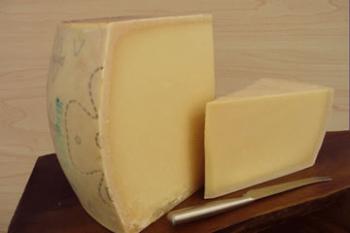Grana Padano
- Producer
- Various
- Country
- Italy
- Region
- Po River Valley
- Size
- 18 in diameter x 9 ins height
- Weight
- 80 lbs
- Website
- Milk
- Cow
- Treatment
- Raw
- Classification
- Hard
- Rennet
- Animal
- Rind
- Natural
- Style
- Grana / Grating cheese

Grana Padano is a hard cheese produced from raw, semi-skimmed cow's milk and often aged for up to two years. In fact, the word “grana” means “grainy”, in reference to the cheese’s granular texture. A single Wheel weighs a hefty 80 pounds, and the thick rind is a dark straw color that can become slightly oily when warm. The interior paste of the cheese is a pale butterscotch, closely textured and dense with no "eyes," or holes. Grana Padano also features crystalline spots of an amino acid called tyrosine, which give the paste an extra crunch.
A close cousin to Parmigiano Reggiano, Grana Padano originated in the 12th century, created by the Cistercian monks of Chiaravalle Abbey. The popularity of the cheese grew rapidly, and by 1200 Grana Padano was being produced by a large number of cheesemakers. Today, the areas of production are Piedmont, Lombardy and Veneto, and in the provinces of Trento, Bologna, Ferrara, Forlì, Piacenza and Ravenna.
In 1996 it gained a protected designation of origin status (or PDO). The designation is placed on foodstuff from a specific region, whose quality is determined by the environment surrounding the particular are, and whose production takes place within that designated region. In the case of Grana Padano, it is prepared, processed, and produced all within the Po River Valley.
Tasting Notes
Grana Padano has a fragrant aroma. On the palate, expect notres of caramel, butterscotch, and tropical fruit flavor.
Pairings
Grana Padana goes beautifully with Italian wines such as Barolo and Gavi. Younger versions pair well with pilsner, while more aged versions pair well with darker, maltier beers. Use as a grating cheese or serve on a cheese board with prosciutto.



